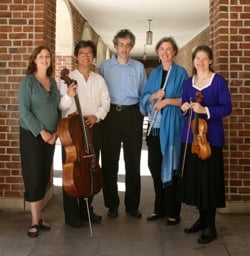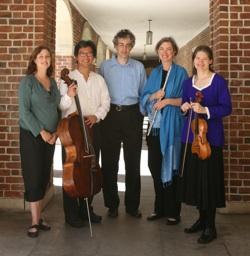
The Left Coast Chamber Ensemble presented an intriguing blend of old and new at the Dennis Gallagher Arts Pavilion in San Francisco in a Monday concert featuring Ross Bauer’s Piano Quartet (2004), Brahms’ Piano Quartet No. 3 in C Minor, Op. 60 (1875), and Hans Werner Henze’s Minette: Canti e rimpianti for two guitars.
Chamber music for piano and strings more or less disappeared in the 20th century. Oh sure, not entirely — there are examples of it — but any list of the top 10 composers will have a large percentage who are not famous for their chamber music for piano and strings. To be clear, we are not referring to works for one string player and a pianist but rather to the straight-up piano trio, the piano quartet, the piano quintet for which there is so much music from the 18th and 19th centuries, written by Beethoven, Schubert, Mendelssohn, Schumann, Dvořák, Fauré, Saint-Saëns, and, of course, Brahms.
The truth of the matter is that the medium is a difficult one for composers. The dichotomy between the piano and the strings all too easily devolves into an either/or competition that poses the questions “Who can play louder? The piano, or all the strings?” Bauer’s Piano Quartet did not fall into this trap. The textures were musical and touching, the moods were varied, and the three movements created a complete and satisfying piece. In truth, though, we were hoping for something more substantial. The piece is excellent, but it was difficult not to burden the Bauer Quartet with our anticipation of the Brahms. Let us say that this is not an opinion about the piece, or the performance, but merely the programming.
The three movements [of the Bauer Piano Quartet] created a complete and satisfying piece.
The Brahms C-minor Piano Quartet is one of the more amazing works for the genre. From the opening, with a burst from the piano followed immediately by a sobbing in the strings, the instruments are constantly used to their best advantage. The Left Coast players performed the first movement with grace and heartbreak. While it seemed that the second movement lacked verve and bite, the third movement sang with a different type of heartbreak, in response to intense beauty rather than intense sorrow. The fourth movement was rocky in places, but by the end, no one in the audience was thinking about anything other than the excitement and emotion of the performance. Every single note had direction, and nothing felt out of place.
Cat Gets All the Toys
Henze’s Minette: Canti e rimpianti for two guitars is a reworking of material from his opera The English Cat. Although not an arrangement of music from the opera, the guitar duo effectively portrays the dramatic arc of the heroine in seven movements. Based on a short story by Balzac, it follows Minette, a young country cat engaged to be married to the important Lord Puff but in love with young Tom, as she gets caught up in the intrigue of the London underworld, grows in wisdom and sorrow, and finally dies a tragic death. As the story begins, the opening “Canzona” shows the naive and childlike worldview of Minette with folk melodies and bird calls. “Air lunare,” Minette’s night song, brings out her more complex longings with polytonality and delightful imitations of meows and purrs, which were performed with an exquisite combination of sensitivity and wry humor by guitarists Michael Goldberg and Marc Teicholz. In “Il cuore spezzato” Minette sings of her broken heart and is interrupted by the inexorable march of time. “Chanson d’adieu” is an almost kitschy ballad that Minette sings as she is tied up in a sack to be drowned and that ends with a glorious lament designed as an homage to Purcell.
Minette’s night song ... [was] performed with an exquisite combination of sensitivity and wry humor by guitarists Michael Goldberg and Marc Teicholz.
The final movement, “La morte amorosa,” is the most complex, both psychologically and musically. Henze’s note says Minette “glides towards the sea, bids farewell to life and blesses the world one last time.” The music departs from the tempered system of intonation with wonderfully expressive string bends, glissandos, and indeterminate pitches, which Goldberg and Teicholz performed with exquisite timing and color. Michael Goldberg deserves special praise for programming this little known but marvelously inventive work.

